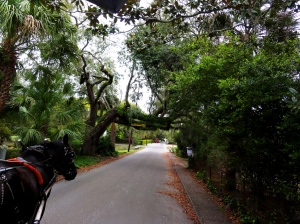
Saxton House (1845) — During the Civil War the Union soldiers occupied this house. — The stairs on the left are to be used by only women, and the stairs on the right are to be used by only men. The reason is that men were not allowed to look at women's ankles!! It was considered a crime!!!
March 29-30. We’re off again, alone (you, me and Magoo) leaving the dock at 8:30am. It’s cloudy and we’re looking at a rainy week, so progress is questionable. There’s some stretches without marinas; we’ll just take it one day at a time. Today our destination is Beaufort, SC, a place we have not been before. So if we are rained in there, it will give us more of an opportunity to explore the area. – As we move along we pass the famous Parris Island Marine base, built in 1861.
Beaufort, SC is the second-oldest city in South Carolina (chartered in 1711). It is noted for maintaining its historic character with its antebellum architecture. This city has been featured in the New York Times, named “Best Small Southern Town”. – The military’s presence (U.S. Naval Hospital, Marine Corps Air Station Beaufort, and Parris Island close by) is a significant part of Beaufort.
The capt’n and I took a horse and buggy ride to get the highlights of the town and sampled a few restaurants cuisines. The town has a beautiful waterfront park with lots of shops, restaurants, and beautiful old buildings. – We learned something interesting. We knew that Beaufort, NC and Beaufort, SC had a different pronunciation, but often got it confused. Our tour guide told us a way to remember the difference. Beaufort, SC is BEAUtiful, and that is exactly how your pronounce BEAUfort, SC. Beaufort, NC is pronounced a different way, BOWfort, NC.






Comments are closed.